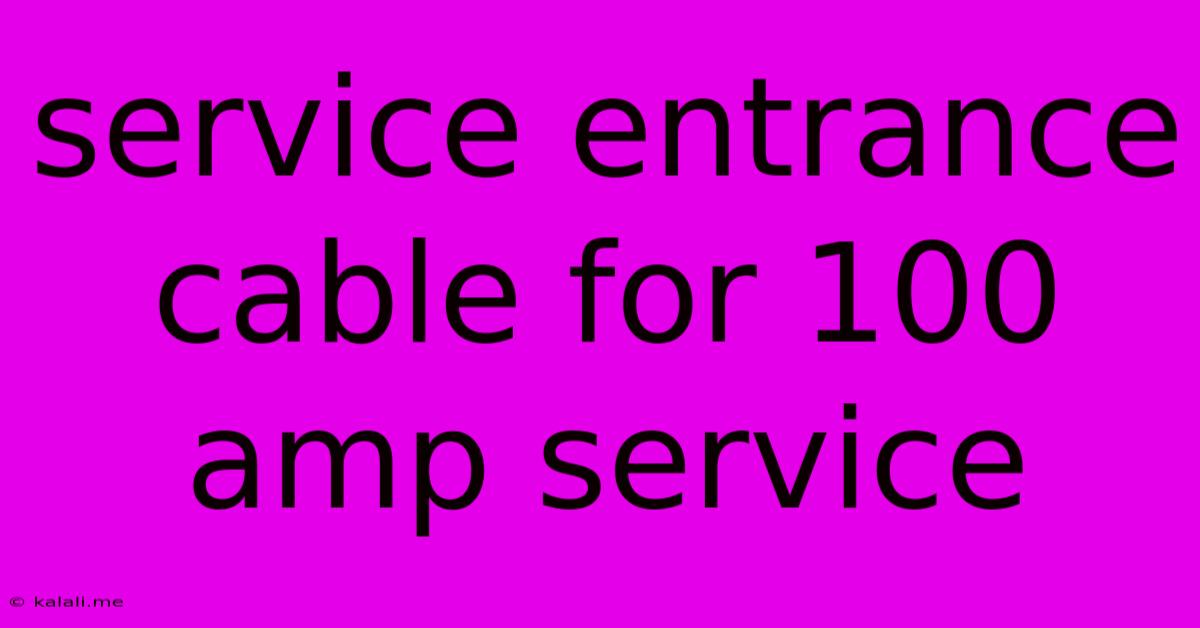Service Entrance Cable For 100 Amp Service
Kalali
Jun 02, 2025 · 3 min read

Table of Contents
Choosing the Right Service Entrance Cable for a 100 Amp Service
Are you upgrading your electrical system to a 100-amp service? Choosing the correct service entrance cable is crucial for safety and code compliance. This comprehensive guide will walk you through the essential factors to consider when selecting the right cable for your 100-amp electrical needs, ensuring a safe and efficient power supply to your home or business. We'll cover cable types, sizing, and installation considerations.
Understanding Service Entrance Cable Requirements
A 100-amp service demands a cable capable of safely handling this amperage without overheating or posing a fire hazard. The National Electrical Code (NEC) dictates specific requirements for service entrance cables, ensuring proper sizing and material selection for various applications. Improper selection can lead to costly repairs, potential electrical hazards, and even voided insurance policies.
Key Factors to Consider:
1. Ampacity and Wire Gauge:
-
Ampacity: This refers to the maximum current a cable can carry continuously without exceeding its temperature rating. For a 100-amp service, you'll need a cable with an ampacity rating significantly higher than 100 amps to account for voltage drop and future load increases. A common choice is a cable with a minimum ampacity of 125 amps.
-
Wire Gauge: The gauge (thickness) of the wire directly correlates to its ampacity. Larger gauge numbers (e.g., 2/0 AWG) represent thicker wires with higher ampacity. Consult the NEC or a wire ampacity chart to determine the appropriate gauge for your 100-amp service. You'll likely need a substantial gauge, such as 2/0 AWG or possibly even larger depending on your specific circumstances (cable length, ambient temperature, etc.).
2. Cable Type:
Several cable types are suitable for service entrance applications, each with its own advantages and disadvantages:
-
Aluminum vs. Copper: Copper cables offer superior conductivity and are generally preferred, but aluminum cables are a more cost-effective option. However, aluminum requires special connectors and installation techniques.
-
SE Cable (Service Entrance Cable): This is a popular choice designed specifically for service entrance applications. It often includes an outer jacket for added protection and may incorporate multiple conductors within a single cable.
-
USE Cable (Underground Service Entrance Cable): If your service entrance runs underground, USE cable is necessary to provide the necessary protection from moisture and soil damage.
-
Other Cable Types: Other types may exist; always consult with a qualified electrician to ensure compliance with local electrical codes.
3. Number of Conductors:
A 100-amp service typically requires at least three conductors: two hot conductors, one neutral conductor, and a ground wire. Consider the need for additional conductors based on your specific electrical needs and future expansion plans.
4. Cable Length and Voltage Drop:
Longer cable runs lead to increased voltage drop. This voltage drop can reduce the efficiency of your electrical system and potentially necessitate a larger cable size to compensate. Consult a voltage drop calculator to determine the appropriate cable size for your specific run length.
5. Installation Location and Environmental Factors:
- Indoor vs. Outdoor: Outdoor installations require cables with enhanced weather resistance and UV protection.
- Direct Burial: If the cable is buried directly in the ground, USE cable is mandatory to protect it from damage and moisture.
- Ambient Temperature: Higher ambient temperatures can reduce the ampacity of the cable.
Professional Installation is Crucial:
Installing service entrance cable is a complex task that should be performed by a qualified and licensed electrician. Improper installation can result in serious safety hazards, including electrical shock and fire. An electrician will ensure the cable is properly sized, installed according to code, and connected to the service panel correctly.
Conclusion:
Selecting the appropriate service entrance cable for a 100-amp service is critical for ensuring safety and electrical system efficiency. Remember to factor in ampacity, wire gauge, cable type, number of conductors, voltage drop, installation location, and environmental conditions when making your selection. Always consult with a qualified electrician to confirm the correct cable type and size for your specific needs and to ensure proper installation, code compliance, and avoidance of potential hazards.
Latest Posts
Latest Posts
-
My Teenager Is Failing School And Doesnt Care
Jun 03, 2025
-
How To Fix A Greasy Spaghetti Sauce
Jun 03, 2025
-
How To Play D Chord On Guitar
Jun 03, 2025
-
Drywall On Ceiling Or Wall First
Jun 03, 2025
-
Air Conditioner Indoor Unit Leaking Water
Jun 03, 2025
Related Post
Thank you for visiting our website which covers about Service Entrance Cable For 100 Amp Service . We hope the information provided has been useful to you. Feel free to contact us if you have any questions or need further assistance. See you next time and don't miss to bookmark.